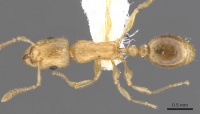Tetramorium isipingense
| Tetramorium isipingense | |
|---|---|

| |
| Scientific classification | |
| Kingdom: | Animalia |
| Phylum: | Arthropoda |
| Class: | Insecta |
| Order: | Hymenoptera |
| Family: | Formicidae |
| Subfamily: | Myrmicinae |
| Tribe: | Crematogastrini |
| Genus: | Tetramorium |
| Species: | T. isipingense |
| Binomial name | |
| Tetramorium isipingense Forel, 1914 | |
Nothing is known about the biology of Tetramorium isipingense.
Identification
Bolton (1980) - Of the five species included in the dumezi-complex of this group only T. isipingense and Tetramorium candidum have standing pubescence on the outer surfaces of the hind tibiae. They are easily separated as the gaster in T. candidum is smooth and unsculptured whilst the gaster in T. isipingense is densely punctulate.
Keys including this Species
Distribution
Latitudinal Distribution Pattern
Latitudinal Range: -30° to -30°.
| North Temperate |
North Subtropical |
Tropical | South Subtropical |
South Temperate |
- Source: AntMaps
Distribution based on Regional Taxon Lists
Afrotropical Region: South Africa (type locality).
Distribution based on AntMaps
Distribution based on AntWeb specimens
Check data from AntWeb
Countries Occupied
| Number of countries occupied by this species based on AntWiki Regional Taxon Lists. In general, fewer countries occupied indicates a narrower range, while more countries indicates a more widespread species. |

|
Estimated Abundance
| Relative abundance based on number of AntMaps records per species (this species within the purple bar). Fewer records (to the left) indicates a less abundant/encountered species while more records (to the right) indicates more abundant/encountered species. |

|
Biology
Castes
Nomenclature
The following information is derived from Barry Bolton's Online Catalogue of the Ants of the World.
- isipingense. Tetramorium simillimum r. isipingense Forel, 1914d: 225 (w.) SOUTH AFRICA. Raised to species: Bolton, 1980: 347.
Unless otherwise noted the text for the remainder of this section is reported from the publication that includes the original description.
Description
Worker
Bolton (1980) - TL 3.2-3.3, HL 0.72-0.74, HW 0.60-0.62, CI 81-84, SL 0.47-0.50, SI 78-81, PW 0.44-0.48, AL 0.88-0.90 (3 measured).
Mandibles smooth and shining with scattered minute pits. Anterior clypeal margin entire, without trace of a median notch. Median clypeal carina strong posteriorly but tending to fade out on anterior half and usually failing to reach the anterior margin; one or two pairs of weak lateral carinae also present on median portion of clypeus. Frontal carinae narrow and fine but quite sharply defined, extending back almost to occipital margin without interruption. Maximum diameter of eye 0.15-0.16, about 0.25-0.27 x HW and with 8-9 ommatidia in the longest row. Head in full-face view with the sides approximately parallel and more or less straight, not evenly convex. Propodeum armed with a pair of minute tubercles or denticles, the metapleural lobes acutely triangular and very much larger than the tiny propodeal armament. Petiole in profile with the dorsal length less than the height of the tergal portion, the posterodorsal angle much broader and more smoothly rounded than the anterodorsal and the sides slightly convergent from base to apex so that the node is narrower above than below. In dorsal view the petiole node subglobular, slightly broader than long. Dorsum of head finely and weakly longitudinally rugulose, with a few anastomoses on the occiput but without a reticulum. Ground-sculpture very feeble, at most a faint glossy superficial patterning. Dorsal alitrunk with faint but quite dense irregular rugulation and a superficial very feebly shagreened ground-sculpture, glossy. Petiole and postpetiole both more or less smooth in places and with patchy vestiges of very feeble ground-sculpture; the former also with a few faint rugulae. First gastral tergite everywhere finely and densely punctulate, more distinct basally than apically but nearly everywhere with narrow shining areas between each minute puncture. All dorsal surfaces of head and body with fine acute hairs, mostly quite short but the longest of those on the pronotum equal to or greater than the maximum diameter of the eye. Dorsal (outer) surfaces of middle and hind tibiae with short erect or suberect pubescence, and leading edges of scapes with similar pubescence. Colour uniform clear pale yellow.
Type Material
Bolton (1980) - Syntype workers, SOUTH AFRICA: Natal, Isipinga, 19.iii.1914, no. 303 (W. B. Marley) (The Natural History Museum; Natural History Museum of Zimbabwe) [examined].
References
- Bolton, B. 1980. The ant tribe Tetramoriini (Hymenoptera: Formicidae). The genus Tetramorium Mayr in the Ethiopian zoogeographical region. Bulletin of the British Museum (Natural History) Entomology. 40(3):193-384.
- Forel, A. 1914d. Formicides d'Afrique et d'Amérique nouveaux ou peu connus. Bull. Soc. Vaudoise Sci. Nat. 50: 211-288 (page 225, worker described)
References based on Global Ant Biodiversity Informatics
- Arnold G. 1917. A monograph of the Formicidae of South Africa. Part III. Myrmicinae. Annals of the South African Museum. 14: 271-402.
- Forel A. 1914. Formicides d'Afrique et d'Amérique nouveaux ou peu connus. Bulletin de la Société Vaudoise des Sciences Naturelles 50: 211-288.
- Wheeler W. M. 1922. Ants of the American Museum Congo expedition. A contribution to the myrmecology of Africa. VIII. A synonymic list of the ants of the Ethiopian region. Bulletin of the American Museum of Natural History 45: 711-1004

